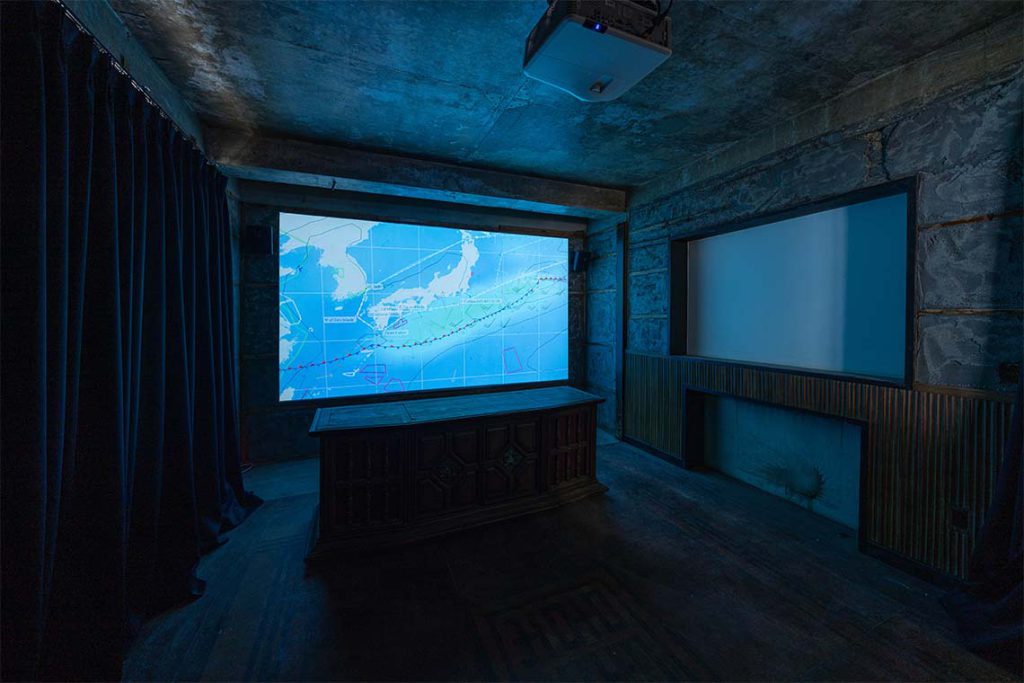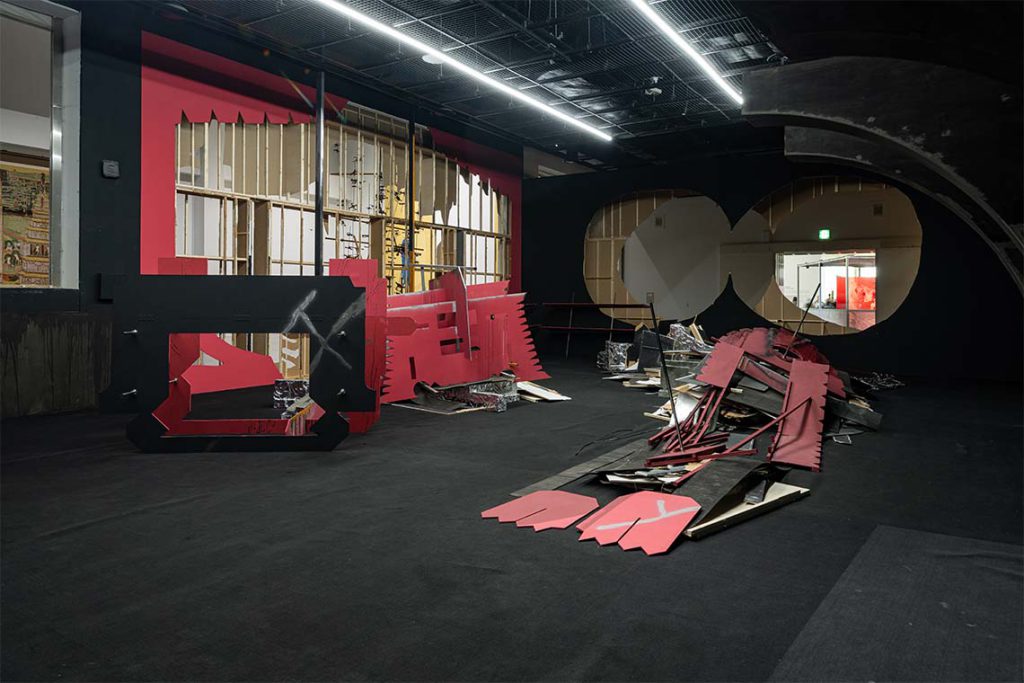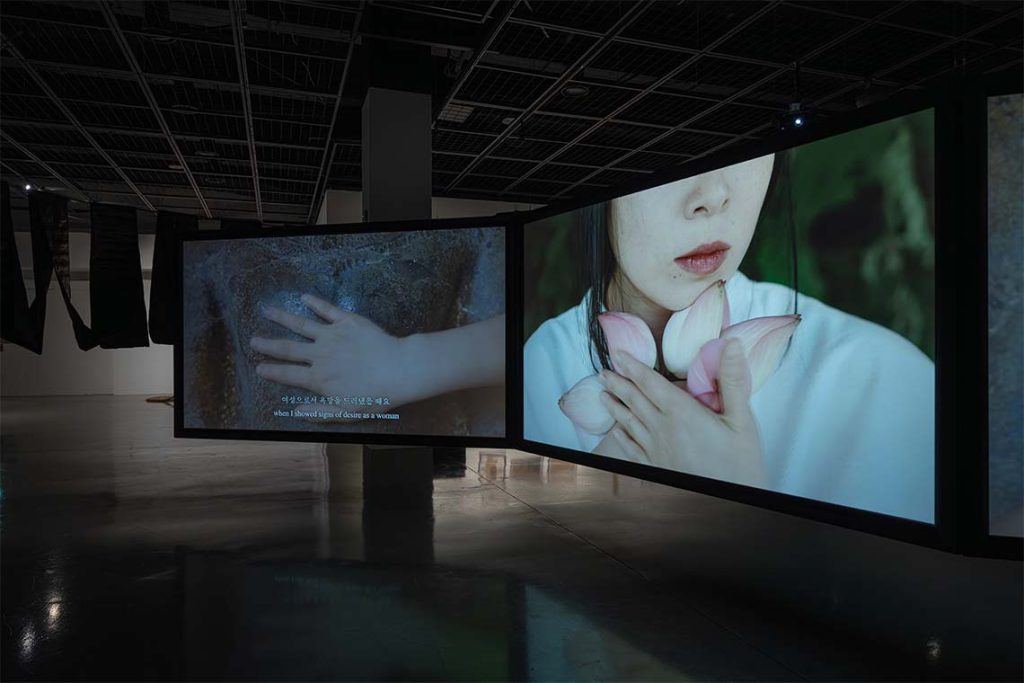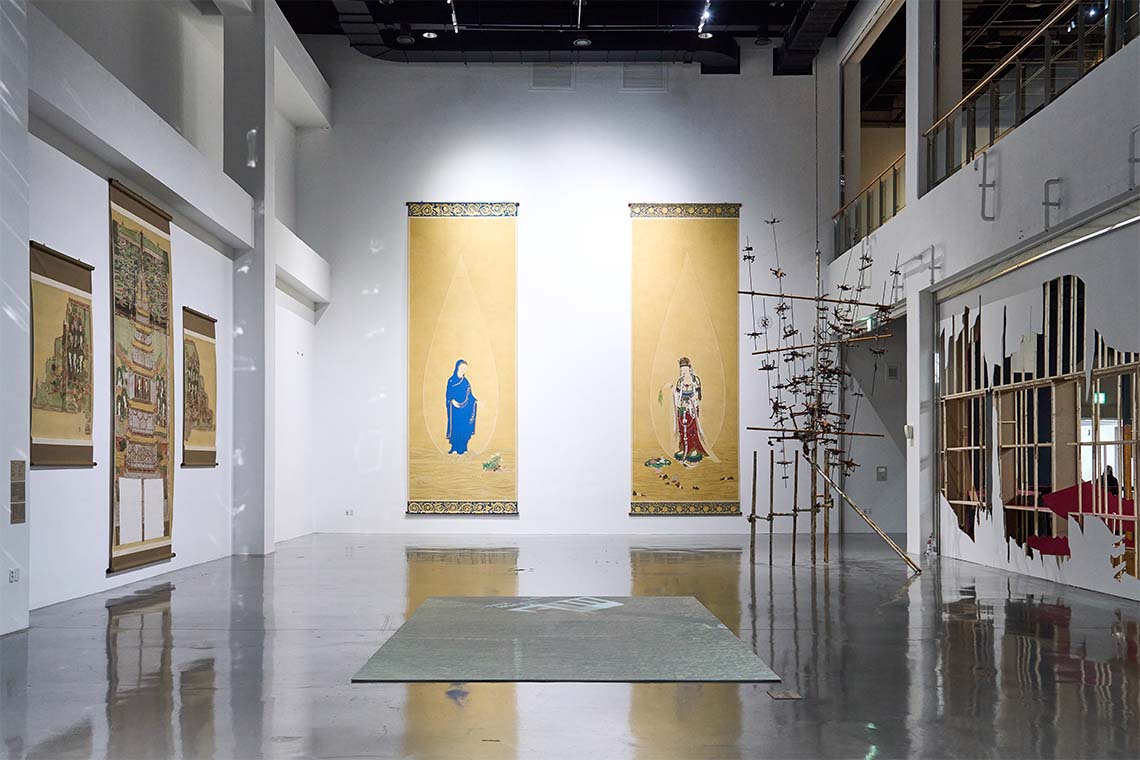This year’s Busan Biennale, Seeing in the Dark, invites viewers to reconsider darkness not only as a space of obscurity but as a ground for new forms of connection, understanding and resistance.
Being plunged into utter darkness – whether it be literal or metaphorical – is a deeply unsettling experience. Feeling as if one has dissolved into a shapeless mass, unable to comprehend one’s place in the dis/order of things, both agitates and enervates, leaving a sense of paralysis. But past this moment lies a different mode of taking up space in the world, where sight gives way to other senses: smell, sound, touch and, perhaps most importantly, interdependence.
This generative quality of darkness serves as the departure point for this year’s Busan Biennale, Seeing in the Dark. As articulated in the curatorial statement by co-artistic directors Vera Mey and Philippe Pirotte, along with associate curator Suzy Park, alternative ways of existing and communing with others are born from the depths of darkness, like Buddhist monasticism or the experimentally egalitarian pirate societies formed in Madagascar between the 16th and 18th centuries – both of which serve as the conceptual grounds for the show.
Although not overwhelming in scale compared to other larger biennales, Seeing in the Dark resists offering itself transparently to visitors. The 349 works by 62 artists and collectives – including a considered selection from the WANASA region that includes Golrokh Nafisi with Ahmadali Kadivar, Shuruq Harb with Federica Bueti, Sophia Al-Maria, Subversive Film and Joe Namy – are spread throughout four venues across Busan, requiring one to traverse the city to make sense of the show as a whole.

At some point in one’s travels, however, one realises that there is perhaps no coherent whole to comprehend. The two disparate threads of Buddhist enlightenment and pirate enlightenment struggle to hold the show together at times, let alone connect meaningfully with the works on display. Zishi Han’s moths (2024), an installation consisting of a video work and vibrating metal sculptures at Busan Modern & Contemporary History Museum (BMCHM), is a standout for literally using darkness to perform its liberatory potential. As visitors sit or stand in a compact and nearly pitch-black space, they are confronted with a big screen displaying moths in darkness. Enlarged, blurred and enveloped in mesmerising purple light, the insects captivate yet defy the viewer’s gaze, evading objectification and categorisation. As the film eventually drowns into darkness, amplifying the metallic hum of the shuddering sculptures nearby, the boundaries between the subject and object dissolve further, opening up a new kind of relation between the two that is characterised by non-hierarchy. The work is a powerful instance of darkness enabling the destabilisation of fixed perspectives. Yet the work’s connection to the biennale’s themes of Buddhist or pirate enlightenment remains tenuous.
The least convincing moments in Seeing in the Dark arise from works produced in direct response to its thematic strands. Street artist Koo Hunjoo’s portraits of South Korean presidents reimagined as pirates at BMCHM, and Buddhist monk Song Cheon’s eight-metre-painting Avalokiteshvara and Mary The Truth Has Never Left My Side (2024) at Busan Museum of Contemporary Art (BMCA) are two examples. While the curators should be applauded for encouraging bold artistic experimentation, its significance beyond the biennale is doubtful. Given Koo’s background as a graffiti artist, would it have made more sense to show work that closely resonates with the local context in an outdoor space? And why not showcase more of Song Cheon’s existing body of excellent work, instead of a new painting that feels more like an illustration of the biennale’s thematic ambitions than a meaningful extension of the artist’s practice? These are some of the questions that linger as visitors navigate the show.

cement, stainless steel pipes and other mixed materials, dimension variable. ⓒ Busan Biennale Organizing Committee
This is not to say that there are no good works aligned with the biennale’s themes. Eugene Jung’s W💀W (Waves of Wreckage) (2024) at BMCA takes the notion of pirate ships as a “space for liberation for those who suffered from the relentless and dense calamities of reality: disease, povertyand hunger”, and shatters it down into heaps of wooden strips and sticks sprawled across the floor. From the outside, the seemingly unimpressive work speaks to the violence of capitalist structures, which threaten to demolish any opposing forces in their way. Upon stepping inside the installation, however, the debris transforms into a landscape imbued with a sense of potential – each scrap becomes a possibility for a renewed journey against the rough waves of capitalism and a piece of novel communities of resistance.
The motif of ships is echoed in Shuruq Harb and Federica Bueti’s Off You Shore Paper Trail (2024) at Choryang House. Set in the Hellas Liberty Museum, a former liberty ship (a type of cargo vessel) that today serves as a floating museum in Athens, the work pairs video footage of vessels, archival materials, maps and voiceovers to explore ships as a site that both facilitates and polices movement across the (Mediterranean) sea with all the attendant hopes and senses of despair.

46 minutes 13 seconds. ⓒ Busan Biennale Organizing Committee
Some of the most memorable works from the biennale centre on the artist’s own body as a way of exploring the affects and utterances of the subaltern (a term used in postcolonial theory to refer to marginalised and oppressed social groups in societies, particularly in the context of colonialism), which in turn reconfigures the meaning of darkness. Han Mengyun’s Night Sutra (2024), a riveting three-channel video embedded in a lustrous, black Dong textile installation, presents a visceral image in which the artist rubs a mixture of egg and black ink over her stretch mark-bearing stomach. As the dark liquid spreads and drips, it hints at the unfathomable depths of creative potency of the female body in labour, and darkness emerges as an emancipatory space that affords expression and poetry. Another example is Hélène Amouzou’s spectral self-portraits on the basement floor of BMCA. Throughout her Autoportrait (2008–2019/2024) series, the artist’s partially effaced, translucent body is softly superimposed on more solid elements like walls or a suitcase, reflecting her experience of social and political invisibility as a migrant. Yet at the same time, the photographs assert her agency, as Amouzou plays with darkness and light to articulate images of herself in the world.
The struggle of Seeing in the Dark’s themes – Buddhist and pirate enlightenments – to tie the show together into a whole could be seen as a curatorial shortcoming. Yet, if Seeing in the Dark is considered a curatorial methodology in itself, the biennale may be evaluated otherwise. To see in the dark is to relinquish the need to grasp the whole or control every aspect, and perhaps that is precisely what the artistic directors have prioritised: the embrace of experimentation, which inevitably courts the risk of failure, and allowing for intimate, one-on-one encounters with the works, rather than striving for complete thematic unity. The result is an ambitious, visually striking exhibition of extraordinary works by artists from diverse creative and cultural backgrounds. And, in this space, darkness indeed becomes fertile ground, ripe with new possibilities.



